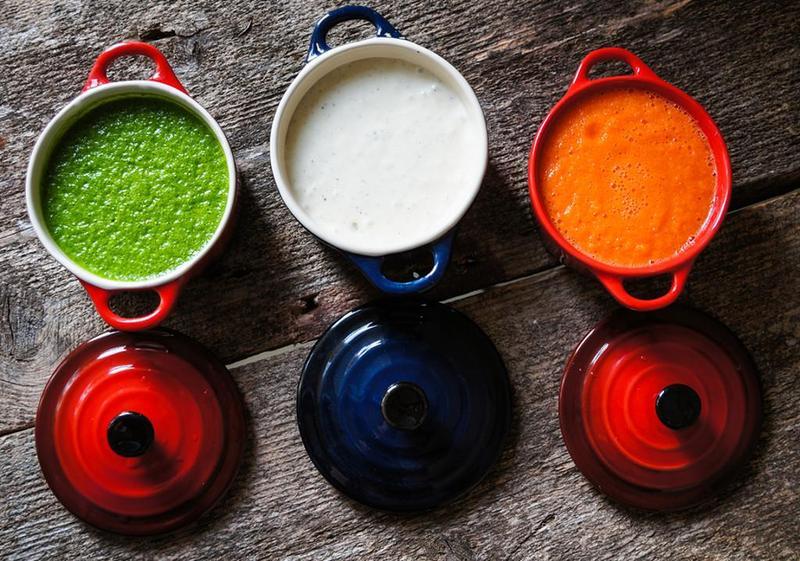Is Souping Healthier Than Juicing?
Is Souping Healthier Than Juicing?
You can think of the budding souping movement as juicing 2.0. Instead of guzzling bottle after bottle of fruit and vegetable drinks to detox or lose weight, trendsetters are now slurping down bowls of cauliflower and lentil concoctions to cleanse their system.
The typical souping plan involves substituting four to six servings of different vegetable-based blends for standard meals and snacks. Some followers are choosing to prepare their own menus at home with guidance from one of several soup cleanse cookbooks that have been published in recent years. Others are opting to order a complete day or week’s worth of ready-to-eat soups from online retailers.
Souping vs. Juicing: Is There a Difference?
In many ways, souping isn’t all that different from juicing. There’s no magic to either of these regimens. They don’t magically purify your inner organs, revive your body, or cancel out weeks of overindulging in junk food. Since juices and soups are produce-based and generally low in calories, they can both produce weight loss if you’re following a strict regimen for days at a time, or replacing one meal per day with a liquid-based alternative.
In a side-by-side comparison, souping does offer a few advantages to the more commonplace juice cleanse. Soups contain whole vegetables, either in chopped or pureed form, so they retain the health-promoting fiber that gets stripped away when fruits and vegetables are processed through a juicer. That’s a major plus, since fiber is one of produce’s most important assets. Juices also tend to be heavier on fruit than vegetables, which can add up to sugar overload when all that fruit is concentrated in liquid form. Indeed, some popular juice cleanses provide more than two thirds of their total calories as sugar, with little fiber, protein, or healthy fat to moderate the impact on blood sugar.
Souping: Pay Attention to Protein
Soup regimens can pack in more protein than juices if they include hearty blends made with beans, lentils, or nuts. However, if the majority of the soups are vegetable-based, like the carrot, cauliflower, and pumpkin purees that are popular in online delivery programs, you’ll still fall far short of your daily protein requirement. That’s not a concern if you’re following a one-day detox, but if you’re cutting calories without including adequate protein for days or weeks at a time, you’ll sacrifice more of your lean muscle tissue while losing weight. If you’re souping for an extended period, you can avoid this dilemma by including protein-rich ingredients in every bowl — think beans, nuts, yogurt, and, if you choose to go the non-vegetarian route, seafood and poultry.
Beware of Souping Sticker Shock
Another potential downside is the cost. Homemade soups are fairly inexpensive as meals go, but specialty mail-order cleanses can run you $70 for a single day (or about $14 per soup serving). That’s hard to swallow. For the same cost, you could stock up on an entire week’s worth of healthy groceries. Even if you don’t do much cooking, you could spend substantially less on three balanced, veggie-based meals at high-quality eateries and accomplish the same end goal.
If a day-long soup cleanse speaks to you, go for it — there’s certainly no harm in slurping up a few quarts of vegetables over the course of 24 hours, and if you feel markedly better at the end of it, that’s worth something. But you don’t have to go to extremes. A better idea might be to replace one meal a day with a hearty, broth-based soup that includes plenty of vegetables and some protein. A big bowl makes a filling lunch or dinner, thanks to the high water content and fiber-rich vegetables, which also keep the calories in check. And, since soup is a classic comfort food, it can be more satisfying than other light fare, like salads. If you’re trying to work more beans, lentils, and whole grains into your diet, a pot of soup is an easy and familiar way to get the job done. Plus, soup is low-maintenance. It holds well, so you can make large quantities and reheat servings during the week, or freeze big batches to keep healthy, homemade meals at your fingertips. (Just make sure to keep the salt to a minimum when cooking soup from scratch.)
by Johannah Sakimura For Everyday Health
Be the first to post a message!
